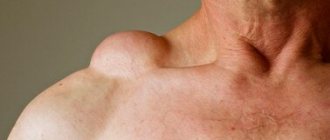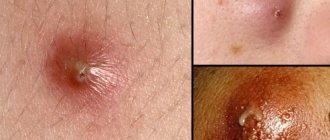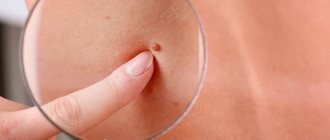Lipoma (popularly called a wen) is a benign tumor formed as a result of the growth of fatty tissue in the body. Subcutaneous disease mainly occurs in people over thirty years of age and extremely rarely appears in children. In exceptional cases, when a lipoma appears on a baby’s body (see photo), it grows along with the baby’s body, and sometimes even outstrips this growth.
There are several types of wen . The most dangerous type of unpleasant neoplasm is considered to be atheroma, which is often confused with a wen. Unlike a wen, the maximum diameter of an atheroma is only 3 cm, but it can cause lightning-fast inflammation and suppuration, since it reacts sharply to any infection present in the human body. The only striking feature of this neoplasm is its dark color. Lipoma, a photo of which is best found on special medical websites, is less dangerous and more treatable.
Reasons for the development of lipoma
Even in the age of active research and technological progress, doctors cannot determine for sure the true cause of the occurrence and further development of the wen, however, there are some theoretical assumptions based on numerous clinical observations. Experts identify the following main factors , which, according to research, can lead to the formation of lipomas on the body, including on the back:
- hereditary predisposition to neoplasms;
- poor environmental situation in the region and environmental pollution;
- metabolic disease;
- menopause in women;
- sedentary and sedentary lifestyle;
- recently suffered infectious diseases of various types;
- disorders associated with the protein fermentation system in the body;
- unbalanced or unhealthy diet;
- hypothalamic injury;
- the presence of a large amount of toxins in the body;
- blockage of the sebaceous gland (the only reliable reason for the appearance of a wen), which leads to excessive formation of subcutaneous fat in the back area.
Wen or lymph node?
Often the wen looks like a hardened, inflamed lymph node. However, fatty tissue is easy to distinguish from a lymph node, since the appearance of a lymph node is often associated with an increase in body temperature or some kind of infectious or inflammatory disease. Lymph nodes are located in certain places of the human body, while a wen (lipoma) can be localized in any part of the body where there is subcutaneous fatty tissue. The lymph node can often be painful when pressed (a lipoma will be painless).
Treatment of the disease and removal of the wen
Before starting lipoma treatment, it is recommended to consult an endocrinologist to ensure the accuracy of your self-made diagnosis and receive competent recommendations for treatment at home. You can also resort to a quick solution to the problem - complete surgical removal of the wen (photos and videos are attached).
The most common ways to get rid of lipoma are the following treatment options and removal of the tumor.
- Drug therapy . This type of treatment makes sense to prescribe if the tumor has just appeared and has not yet begun to develop. The procedure involves the introduction of special absorbable drugs into the body of the wen and is carried out in a day hospital or at home. The only drawback of this treatment method is the high risk of relapse.
- Laser removal . This means of combating is considered the most effective and safe, since after laser therapy there are no traces left, the procedure itself and the process of recovery of the body after it pass very quickly, the laser beam affects strictly the area affected by the disease and does not affect the tissue adjacent to the lipoma.
- Liposuction . This treatment method is based on the classical system of fat suction from a specific area of the body. The lipoma is softened artificially, and then its contents are removed using a special tube, after applying local anesthesia.
- Radio wave therapy . This method ensures painless removal of the wen using a so-called radio knife. The therapy has a number of undeniable advantages: complete absence of pain, bloodless operation, low risk of any complications, rapid recovery of the body after the procedure and the absence of postoperative marks on the body, for example, scars or cicatrices.
- Surgical intervention . A small lump on the back or elsewhere is quickly removed on an outpatient basis, but surgery to remove a large tumor is performed in the surgical department, after which the patient remains in the hospital for several days. Surgical removal of a large lipoma occurs using a scalpel, which is used to incise the skin over the tumor, and then the contents of the wen are pumped out and an antiseptic composition is injected into the cavity. As with liposuction, the anesthesiologist administers local anesthesia before the operation. The disadvantage of this procedure is the high probability of the formation of a noticeable scar at the site of the removed wen.
- Unconventional treatment . Traditional medicine methods are relevant when treating lipoma at home. The most effective methods are considered to be different types of compresses (an alcohol compress based on vegetable oil and vodka and a compress made from aloe leaves) and applying ichthyol ointment or Vishnevsky ointment to the wen. The above procedures lead to a relatively quick opening of the wen and further removal of its contents from the body.
Before choosing a lipoma treatment method, it is recommended to familiarize yourself with photos and videos in order to resort to the most suitable method of therapy in a particular case.
"Eternal" pimple
Natalya Sokolova, head of the clinic of the Akmola Regional Dermatovenerological Dispensary, told the Good Health magazine about how to distinguish a wen from a pimple and how to get rid of it.
The accumulation of sebum can be called differently - a sebaceous cyst, a lipoma, but the popular definition of “fat” is most often used. In any case, this is a formation in which fat accumulates.
“A person can diagnose it himself - most often wen appear on the face, back, hands, hips, legs,” says Natalya Evgenievna. – Often a wen passes itself off as an ordinary subcutaneous pimple. But the difference is that the pimple goes away, but the wen does not. If you press on it, nothing hurts - it may even be soft to the touch.
Wen can reach a diameter of 5 cm. Of course, if a person has “grown” it to this size, he needs to see a doctor.
– Why do they appear on the body?
– There are several versions. The ducts of the sebaceous gland can become clogged and clogged, causing a fat capsule to form in this area over time. We also noticed that wen appears in an area where the number of fat cells increases. There is also a version that due to diet, fat thickens, is difficult to excrete and remains under the skin.
– Is there a category of people who most often encounter lipoma?
– No, wen appears in both men and women, adults and even children. By the way, children under five years old should not remove it.
– Should I worry if a wen appears on my body?
– In most cases, there is no cause for concern, unless the wen is gigantic in size. And yet, a person must understand that a wen is a benign skin tumor. If it hurts or begins to grow rapidly, then you need to see a doctor.
– Is it possible to squeeze out a wen?
– It is not advisable to squeeze out. Microbes that are in the closed cavity of the cyst, when ruptured, end up on healthy skin, which is not good. Moreover, if it bursts inside, it can even lead to sepsis.
– What methods can you use to get rid of wen? Or will the person have to live with him until the end of his days?
– Before starting treatment, the doctor must make sure that it is definitely a wen. Ultrasound examination will help him with this. A biopsy will also need to be done.
If the lipoma is small, you can inject a substance into the wen that will absorb the fat. If the doctor sees that the wen is growing, especially on the head, in the eye area, or spoils the patient’s appearance, he may suggest a surgical method. I must warn you that after such treatment scars remain on the body. You can also “pump out” this wen using a puncture, but this method is not suitable in all cases. Modern medicine also offers laser removal of the wen - it is easier to tolerate than surgery and does not leave any traces. It is very important, after removing a lipoma, to send its contents for histology to make sure that it is not a malignant tumor.
– Do wen come back?
– If the fat was not completely pumped out, then the wen will probably fill with fat again.
– Many people believe that they can get rid of lipoma with the help of traditional medicine. Is it true?
– Many people make some kind of compresses, rub the wen, drink decoctions, and even try to lose weight in the hope that the fat will resolve. I have to disappoint adherents of traditional medicine that their methods practically do not work.
– Can a person take any measures to protect against wen?
– It is within his power to maintain hygiene and prevent injury to the skin. Of course, you should watch your diet
Preparation for the procedure
In case of subcutaneous lipoma removal, no special preparation is required. The mini-surgery is performed on an outpatient basis, meaning it does not require hospitalization. The surgeon performs all necessary manipulations under local anesthesia. Thus, the procedure is painless for the patient.
Giant subcutaneous lipomas, as well as neoplasms of the intestines, internal organs, and peritoneum require more serious and thorough preparation. Operations of this type are carried out with hospitalization of the patient. Before the intervention, samples are taken and, if necessary, additional studies are done. Operations performed under general anesthesia require restriction of water and food on the eve of the operation.
When is it time to see a doctor?
Removal of a lipoma, although it is a radical measure, is the most effective mechanism with minimal risk of recurrence. All sorts of alternative versions of help, such as folk remedies or grandmother's recipes, at best, can work temporarily. In the worst case scenario, they will aggravate the course of the disease, which will be accompanied by negative consequences in the form of extensive inflammation or even suppuration.
Typically, lipoma removal is carried out according to a planned principle, which means setting a date for the intervention on a certain day, when all the tests have already been completed. But sometimes, if there is an increased risk of immediate damage to surrounding healthy tissue, the doctor may decide to immediately excise the affected area. Regardless of whether the manipulation is planned or emergency, you should not ignore the words of an expert who insists on removing the wen.
The main indications for going “under the scalpel” are the following pathologies and conditions:
- change in shape or color;
- redness of the skin above or near the wen itself;
- pain not only when pressed, but also when simply touched;
- tooth in the problem area;
- even slight swelling;
- suspicion of a malignant tumor.
Ancillary markers of deviation from the norm can be disturbances in the functioning of individual organs located close to the expected affected area. The localization of wen in an area of high trauma is also a reason to remove them as quickly as possible.
No less dangerous is a formation that has taken root near a cluster of blood vessels and nerve cells, which can result in their extensive damage.
Therefore, as soon as the negative impact on surrounding tissues emanating from the lipoma is proven, then it’s time to sign up for the procedure of its excision using a scalpel and local anesthesia.
Symptoms, signs, diagnosis of lipoma
Before you remove a wen, you need to make sure that it is exactly that. The shape of the wen formed under the skin is round or oval. It is mobile and soft to the touch; as a rule, no pain is felt when pressing on it.
Fatty deposits located under the skin of the face, neck, back, arms and other parts of the body usually do not cause any symptoms. A lipoma formed on internal organs causes the following symptoms:
- When a lipoma appears in the esophagus, coughing, nausea, and a feeling that there is a foreign body in the throat may occur;
- Chest pain may be the cause of lipoma formation in the mammary gland;
- Symptoms such as headaches, nausea, and vomiting may occur with a lipoma in the brain.
A lipoma is diagnosed visually during a clinical examination; if this is not enough, using ultrasound, x-rays, and computed tomography.
Scheme of the operation
You can cut out a wen using several types of equipment, ranging from a laser beam to a radio wave knife. But although the presented methods are innovative, they have a number of contraindications that are not characteristic of classical surgical intervention.
To exclude the slightest possibility of a possible relapse or infectious penetration of the open wound surface, it is extremely important to carry out the intervention under conditions of absolute sterility. With this approach, it will be possible to achieve high healing efficiency.
Typically, patients are offered to use local anesthesia, which is sufficient to relieve pain in a relatively small area of surgical activity. But if you have to remove an impressive wen, then it is better to use the service of general anesthesia. The final decision is made by the doctor on the spot, taking into account all the characteristics of his patient.
But there is one caveat. If the lipoma turns out to be small, and the victim is simply afraid of surgery, then you should not risk asking for general anesthesia. Extensive pain relief will not justify itself, only causing significant damage to the cardiovascular system.
To extract adipose tissue, only sterilized instruments are used. And before the actual start of the manipulation, junior medical personnel disinfect the skin.
First, the doctor makes a small incision, after which he adheres to the following standard step-by-step instructions:
- cuts out the adipose tissue along with the capsule, which is called enucleation;
- sutures tissue in layers using self-absorbable threads;
- fixes the scar with an antiseptic bandage.
If it is necessary to involve thin drainages, this indicates that the neoplasm was of significant size. The suture should be removed approximately a week after the intervention, but if we are talking about self-absorbable threads, the timing may shift.
In order to protect the wound from possible penetration of pathogenic microorganisms, the doctor will prescribe ointments or creams. They will not only become a reliable protector against the possible ingress of pathogenic microbes, but will also act as a cure for extensive inflammation or swelling.
Separately, wound healing compounds can be prescribed to speed up the recovery process after extensive excision.











